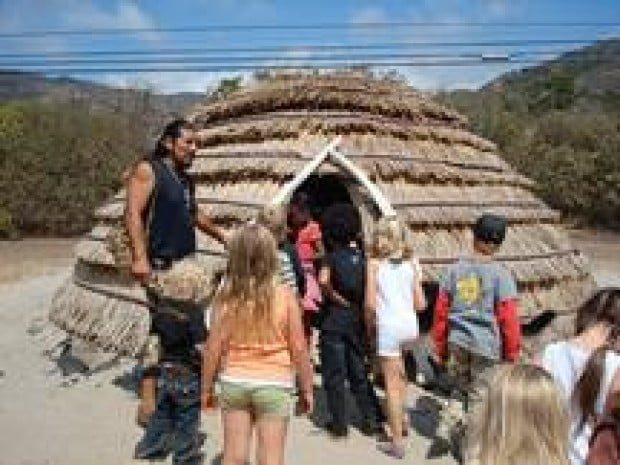
Students from Muse Elementary learn about Chumash culture and environmental protection during a visit to the Chumash Demonstration
Village at Nicholas County Beach.
By Jonathan Friedman / Assistant Editor
“You can only be so strong, do so much. The sooner you know what your limitations are, you can accept what you have to offer.”
Limitation, that is the first of the Three Basic Laws of Chumash culture, said Mati Waiya, executive director of the Wishtoyo Foundation. He shared those words of wisdom with young students from Muse Elementary School last month when the children visited the Chumash Demonstration Village at Nicholas Canyon County Beach.
Waiya also shared the other Chumash laws-Moderation: “Harvest from the lands and oceans just what you need. Leave some for tomorrow and for someone else, don’t be greedy;” and Compensation: “If you want to do something for others, do it because that’s what’s in your heart, not because you want something back.”
The Chumash people have lived in the Malibu area for at least 4,000 years, and possibly as long as 8,000. Waiya and his organization are in the process of creating demonstration village that will give people a window into how the Chumash people lived before the arrival of Europeans, while sharing the values of the culture and creating an atmosphere to bring all people together, regardless of background.
“We want to make the rainbow bridge, and bring all the races and colors of humanity together,” said Tim King, site manager of the property.
The village has been in the works for many years, and construction on the property began two years ago in coordination with the Los Angeles County Department of Beaches and Harbors, which owns the site located just east of County Line. A ceremonial circle, called a sil’i’yik was created, which is where Waiya spoke to the Muse students, as he told them stories about good values, and encouraged them to work toward protecting the environment.
“If a turtle and condor could go to the courtroom and say ‘Hey, you’re hurting us,’ they would,” Waiya said. “But they can’t, so we have to be the ones to step up and help them.”
The property also contains three Chumash homes, called aps. The hut-like facilities are made of the same materials that the ancient Chumash would have used. A frame is built out of willow, and long plant material called tule is applied to the frame to complete the construction. The entrance of two of the aps is made from grey whalebones, and the same thing is planned for the third home.
Waiya said he would like to construct more aps, and wants to continue with the creation of the village, foreseeing a facility with various cultural materials, including a cave-painted wall along the property and canoesbuilt out of the material used by the Chumash. He is currently trying to raise $300,000 to complete his vision.
The demonstration village hosts visiting students and small groups. When it is complete, the Wishtoyo Foundation plans to host larger groups and hold various cultural celebrations throughout the year as well as surf camps, ocean recreation events and other activities.
The students from Muse, a small school in Las Flores Canyon that seeks “to instill in young people a respect for the humanity and ecology of the Earth and the sensitivity to appreciate life’s deep joys and mysteries,” came to the village last month to celebrate the Fall Equinox.
Muse student Henry Carr, who is seven, said, “I really like their culture. Their clothes and their homes are really cool.”
Abrianna Dzilvelis, 6, said she also liked the homes. When asked if she’d like to live in one, she said, “Not really, but they were fun to visit.”
More information about the Wishtoyo Foundation, its Chumash Demonstration Village and environmental protection efforts, can be found online at www.wishtoyo.org.